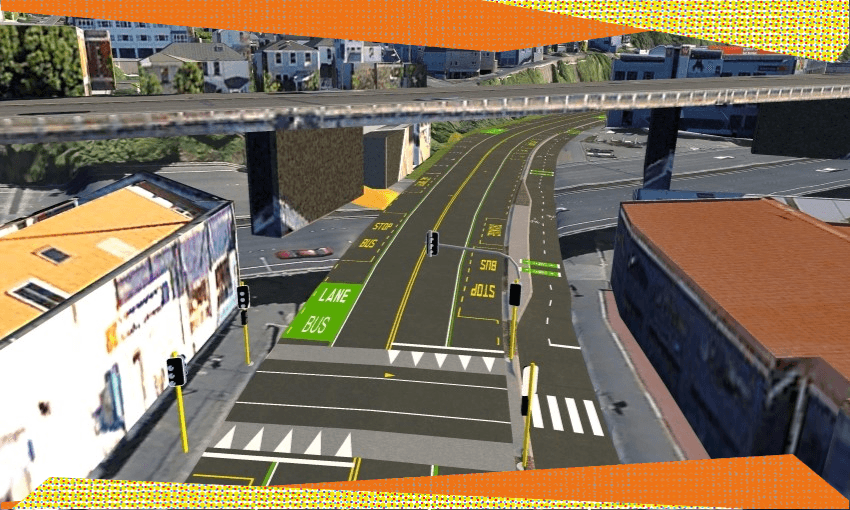Wellington has to do a lot of work redesigning its streets to be more people-friendly. But this particular design went too far.
Windbag is The Spinoff’s Wellington issues column, written by Wellington editor Joel MacManus. It’s made possible thanks to the support of The Spinoff Members.
There are some people who get into local politics because they want to influence change. There are others who are just there to complain about change. It’s a pretty easy gig, really. Any time the council does anything, you run to the newspaper with some quotes calling said thing “madness” or “crazy”.
Councillors Diane Calvert, Tony Randle, and Ray Chung recently appeared on the front page of The Post, looking grumpy about changes to Thorndon Quay. These three councillors are no strangers to complaining about progressive street changes. They’ve tried, repeatedly, to shut down the Golden Mile upgrade, and consistently opposed new bike and bus infrastructure. Calvert once called a bike lane “an assault on democracy”. Randle campaigned on improving bus services to Johnsonville, then once elected, complained about a plan to put in a bus lane to Johnsonville.
Their latest complaint? There are too many pedestrian crossings being built on Thorndon Quay. This time, though, they have a point.
The $55m Thorndon Quay upgrade was originally a Let’s Get Wellington Moving project. It was handed back to Wellington City Council after the programme was dissolved. It has the hallmarks of everything that went wrong with LGWM: it’s taken way too long, it’s too expensive, it’s over-engineered, it accumulated mountains of consultant’s reports, and yet, it still doesn’t seem to know what it is trying to achieve.
The 130-page business case makes it clear the Thorndon Quay project is about moving more people on buses and bikes. The council’s webpage for the project is headlined: “Moving over 11000 commuters a day? Absolutely”.
The third point in the business case – and a much lower priority – was about creating a nicer experience for people walking through the area. The documents show consultants considered a long list of pedestrian options: adding zebra crossings, moving crossings to align with bus stops, adding traffic islands, changing some slip lanes, better seating and lighting.
But instead of making minor pedestrian improvements, the proposed design goes way overboard. Five raised pedestrian crossings with traffic lights, plus a sixth non-raised crossing with traffic lights. It’s a big-budget, gold standard approach, but it goes against the primary aim of the project. Raised crossings and excessive traffic lights will make bus and bike access worse, not better.
Metlink group manager Samantha Gain is wary of criticising the project, but gave this carefully worded statement: “Metlink prefers the installation of traffic control devices, like speed bumps and raised crossings, to be minimised on high frequency bus routes. They can accentuate wear and tear on our buses and reduce ride quality for our passengers.”
Thorndon Quay is the busiest bus corridor outside of the city centre, and is only going to get busier. The northern suburbs are set for a population boom from the upzoning allowed in the District Plan. Thorndon Quay is also the busiest bike corridor anywhere in the city, and that’s set to rise too. The new harbour seawall currently being built will have a shared cycling and walking path running on top of it. With e-bikes becoming increasingly popular, it’s going to unlock thousands of easy and safe journeys per day for commuters from the Hutt to the city via Thorndon Quay.
The changes will make it slightly harder to drive, and it will mean fewer on-street parking spots – but that’s a necessary part of progress. The car parking changes have already raised the ire of Thorndon Quay business owners, who took the council to court over a previous switch from angled to parallel parking. (The group won on process, but the council won’t have to undo any changes).
Wellington, like all New Zealand cities, is going to need to do a lot of work redesigning streets to cater to a growing population, with low-carbon and more space-efficient transport. We have to undo 70 years of transport planning that didn’t consider any transport but the private car. As a general principle, pedestrians should always come first when designing streets. But in this case, Thorndon Quay serves primarily as an arterial route, not as a pedestrian destination. It’s an industrial area, backing onto a railway yard, shadowed by a motorway overpass. It’s never going to be a cutesy neighbourhood shopping centre.
It’s not going to be viable for this project to continue as-is. Some of these crossings will have to be reconfigured so it can actually serve as a useful bus lane. Streets can either be a great place to be, or a convenient space to move through. But it’s very hard to be both. Part of good urban design is picking your priorities – and in the case of Thorndon Quay, they got it wrong.


